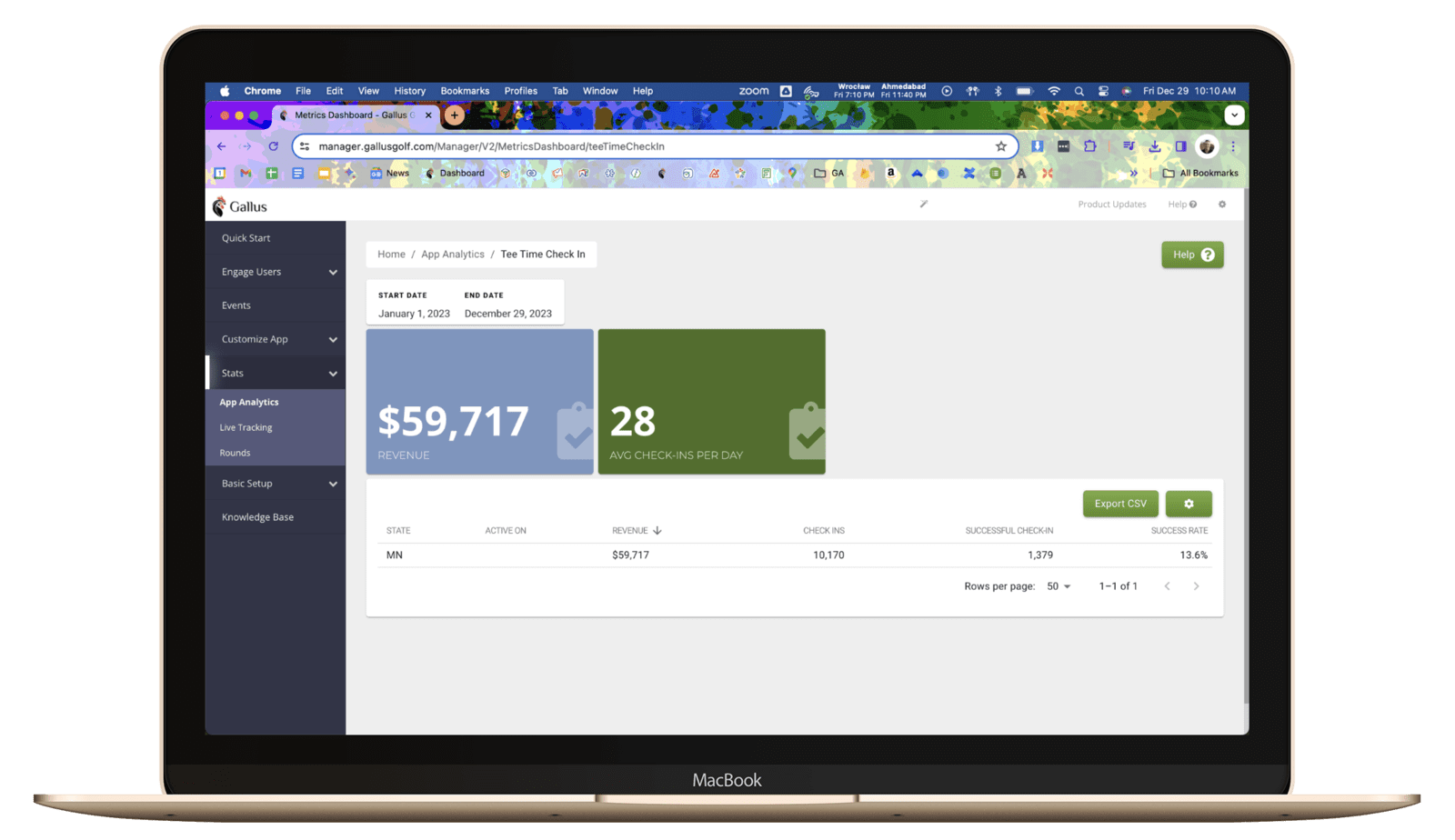
Our past three blog posts have focused on available analytics in three core areas of the Gallus ecosystem: User Data, Push Notifications, and Rewards. As we embark on our final post in this series, it’s important to revisit why analytics are important: without them, you are operating your business in the dark.
We saved this final post because it’s the most crucial metric to check frequently: revenue. To track the money made in any system, tracking must be set up BEFORE customers ever use it. So as we turn the calendar into a new year, let’s make sure you’re ready for a data-driven 2024.
We’ll use this post to walk through strategies for working with your booking engine provider to track different revenue streams, along with detailing the readily available Mobile Check-In metrics available in a Gallus admin dashboard.
Gallus Golf has been an outstanding partner for Marriott Golf. They continue to provide the best mobile app technology for our properties to engage our guests, reach new customers, and provide opportunities to grow revenues.
The team is proactive in making sure our properties are utilizing the most current features, and their support is superior.
Brett Stark
Senior Director, Marketing & Commerce, Marriott Golf

Booking Engine Revenue Insights
Booking Engine Revenue Insights
Tee Times are crucial for golf courses, and diversifying booking engine access across websites, social media, email and your app is key. However, tracking revenue per channel can be challenging with standard POS systems.
Why it matters: Understanding which booking channels generate the most revenue or average revenue per user (ARPU) helps golf courses allocate marketing budgets more effectively, optimizing overall profitability.
By the numbers: Utilizing UTM parameters with Google Analytics or Affiliate parameters with other analytics trackers enables detailed tracking of booking sources, offering insights into user behavior and campaign success.
- MCO partner saw a $16 ARPU in the app across all their golf courses with tracking enabled. For reference, Email hovered around $1 to $2 ARPU.
The big picture: Adding booking engine tracking across multiple platforms allows for a more accurate assessment of your marketing efforts and channel effectiveness.
The bottom line: Effective use of analytics and mobile app technology can significantly improve revenue tracking and operational efficiency for golf courses.
Optimizing Booking Engine Revenue Tracking
Optimizing Booking Engine Revenue Tracking
Finding the most effective revenue tracking method for your booking engine is crucial. Since providers vary, partnering closely with yours is key to quick implementation.
Why it matters: A tailored approach to revenue tracking ensures accurate data collection, essential for informed decision-making and strategy optimization.
Club Prophet's Tracking Method
Club Prophet simplifies revenue tracking from App bookings by automatically adding unique identifiers to URLs, distinguishing between general and waitlist bookings.
Why it matters: This feature allows for granular analysis of revenue streams directly from the app, enabling businesses to pinpoint the most effective channels.
Club Prophet's Affiliate ID allows for automatic appending of unique identifiers to outbound V5 URLs used in the App, enabling tracking of App-driven bookings and their corresponding revenue. Our apps apply this affiliate ID automatically, adding affiliate 1 for general Tee Time bookings through the app and affiliate 2 for tee times booked through our StandBy tee time waitlist feature.
By the numbers: Club Prophet customers can use their Business Intelligence (BI) tool to filter their revenue by those affiliate IDs for detailed metrics and understand how much each channel is driving in revenue.
Enhance Tracking with Google Analytics
Enhance Tracking with Google Analytics
Implementing Google Analytics with your booking engines can unlock detailed insights into customer behavior and revenue streams. Providers should have or allow you to add your Google Analytics tracking to your booking engine site.
Why it matters: Accurate tracking enables golf courses to understand which channels drive bookings and revenue, facilitating smarter marketing and operational decisions.
By the numbers: Using UTM parameters transforms a standard URL into a powerful tracking tool, revealing the source, medium, and campaign behind every booking.
The big picture: Adding Google Analytics to your booking engines, complemented by our automatic UTM parameter insertion, simplifies the process of tracking revenue from various sources providing you insight into booking patterns and campaign effectiveness.

Mobile Check-In Meets Data Insights
Our Mobile Check-In feature isn't just enhancing the check-in process; it's unlocking a wealth of data insights available through our App Analytics module, no extra setup required.
Why it matters: This functionality provides access to detailed metrics on check-in activities, success rates, and directly attributable revenue, demonstrating the significant value of mobile check-in to your operations.
By the numbers: You can access insightful, date-filtered data on check-In activity, success rate and revenue generated giving you a picture of how the app is helping to contribute to your bottom line.
Conclusion
App analytics are not just dashboards; they are springboards for action. When you put the work in to set up tracking you can reap the benefits by using your newfound insights to transform your Gallus app into a true revenue engine, fueling growth and optimizing your course's success.

